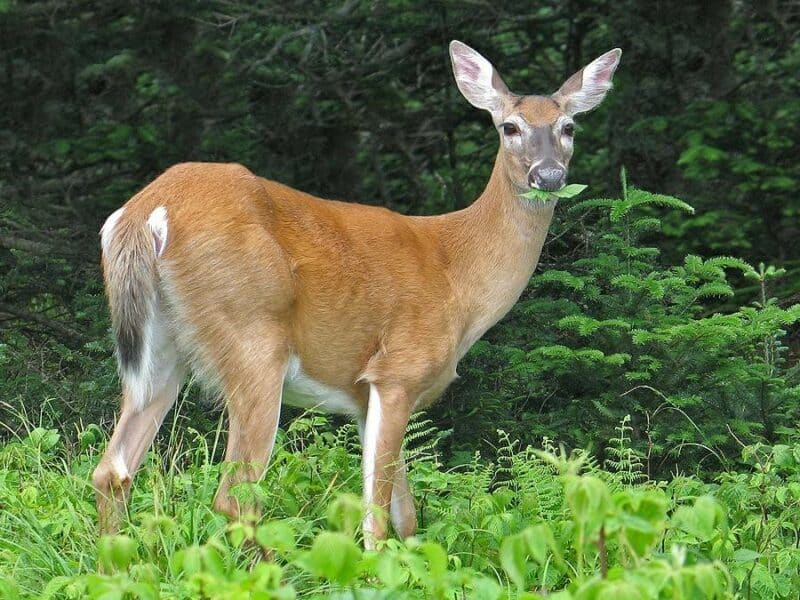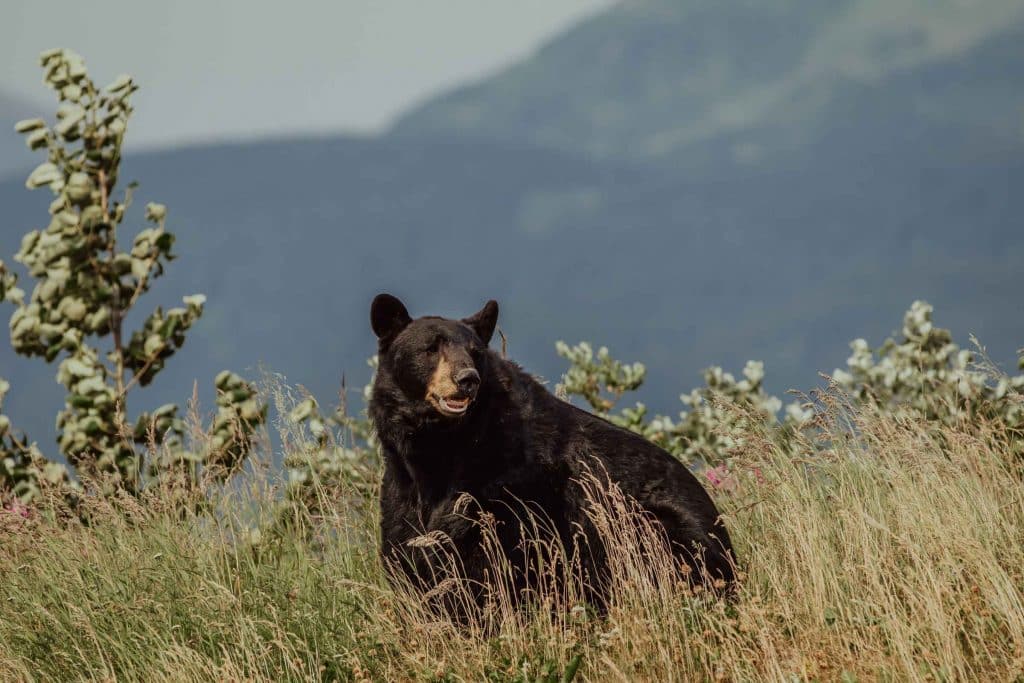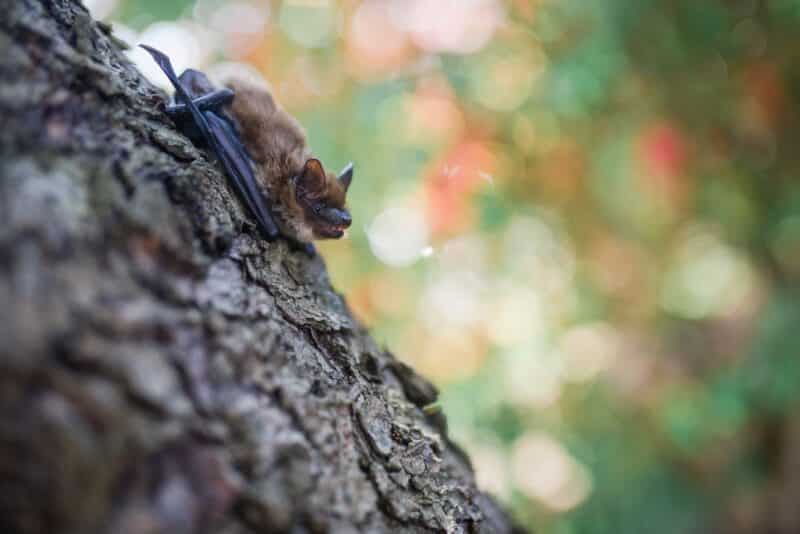Step into the captivating world of animals and wildlife in Ontario!
Canada’s wilderness is a treasure trove of extraordinary creatures, and Ontario takes center stage with its vibrant biodiversity. With a whopping 400 species of birds, this province is a paradise for nature enthusiasts. From the lush forests to the meandering rivers and glistening lakes, Ontario’s vast landscapes are brimming with a diverse array of animals and wildlife, just waiting to be discovered.
Predators such as beavers, otters, mink, fox and wolf, waterfowl, etc., are found here. And you cannot possibly miss the large mammals like polar bears and moose are also found here.
Click below to jump to any section on animals in Ontario:
Key Points
| Animal | Description | Habitat | Diet | Notable Locations in Ontario |
|---|---|---|---|---|
| White-tailed Deer | Medium-sized herbivores known for their reddish-brown to grayish-brown bodies. Reproduce quickly and adapt to climates. | Forests, open areas | Grasses, herbs, woody plants | Trois Lacs Outfitters, Lower St. Lawrence; Indian Point Camp, Dryden; Nestor Falls |
| American Black Bear | Omnivorous bears found in North America with distinctive chest markings. Tree climbers that hibernate in winter. | Forests, urban areas | Small animals, berries, plants | Hudson Bay coast, Chapleau Crown Game Preserve, Algonquin Provincial Park |
| Little Brown Bat | Tiny bats known for using echolocation to hunt insects. Hibernate during winter. | Caves, buildings, forests | Insects, aquatic larvae, occasionally small vertebrates | Moose Factory, Southern Ontario buildings and trees, barns |
| Barn Owl | Golden owls with heart-shaped white faces. Prey on rodents in various environments. | Fields, meadows, orchards, grasslands, buildings | Rodents, small mammals | Southern Ontario, British Columbia |
| Loggerhead Shrike | Robin-sized birds that hunt insects, animals, and birds. Live in grasslands and agricultural lands. | Grasslands, agricultural lands, open areas | Insects, small vertebrates | The Carden Plain north, Napanee Limestone Plain |
| Fisher | Carnivorous, weasel-like animals known for hunting small mammals and porcupines. Climbers. | Forests, deciduous and coniferous habitats, urban areas | Small mammals, birds, occasional vegetation | Frontenac Provincial Park, temperate forests, Parry Sound area, Manitoulin Island, Bruce Peninsula |
| Green-winged Teal | Small dabbling ducks found in boreal forests. Lay eggs in dense vegetation. Travel in fast-moving flocks. | Boreal forests, shallow ponds, lakes, wetlands | Aquatic animals, insects | Bird Sanctuary, Arctic breeding grounds |
| Trumpeter Swan | Large birds found in wetlands, rivers, and lakes. Striking appearance. Feed on aquatic plants. | Wetlands, rivers, lakes | Aquatic plants, submerged vegetation | Wye Marsh, marshes of lakes Ontario, Erie, and St. Clair, Lake Simcoe, Kenora District of Ontario, Big Rideau Lake |
| Big Brown Bat | Common bats known for insectivorous diet. Hibernate in various structures. Adapt well to human environments. | Caves, buildings, trees, urban and rural areas | Insects, occasionally fruit | West Kootenay, Happy Valley Forest, Ottawa Valley, Southern Norfolk Sand Plain, Rice Lake Plains |
| House Sparrow | Social birds closely associated with humans. Common in urban and rural areas. Eat grains and insects. | Urban and rural areas, buildings | Grains, insects, occasional small vertebrates | Houses, trees, shrubby and open areas, amusement parks |
Background of Ontario
Ontario: Nature and Prosperity in Harmony
Ontario, Canada’s second-largest province after Quebec, offers a fascinating interplay between its diverse wildlife and robust economic prowess, all within its vast territory. The province’s climate and geography determine its unique animal inhabitants, while its status as the most populous province, home to over a third of Canada’s population, showcases its cultural vibrancy. Ontario’s wealth, driven by abundant natural resources and a thriving industrial economy, makes it Canada’s economic powerhouse and a significant player in national politics. The province is geographically divided into Northern Ontario, known for its expansive forests and crucial hydroelectric projects, and Southern Ontario, characterized by a picturesque landscape filled with lakes and gentle relief land, providing a remarkable blend of natural beauty and economic vitality.
White-tailed Deer

The white-tailed deer is the first member of our list of animals in Ontario. It is also known as Virginia deer, is medium-sized and native to North America, Central America, and South America. White-tailed deer got its name due to the white hairs under the tail and rump. White-tailed deer have different sizes. Its body is found to be more significant in cold climates and agricultural soil but more petite in deserts and tropics.
It has a reddish-brown to grayish-brown body and large ears. They love to live in open areas and forests. During summer, white-tailed deer are found in forest areas where the food is present more, and in winter, they live in yards where they get proper nutrition and protection from cold winds. They reproduce quickly and are capable of doubling their number in a year.
White-tailed deer are herbivores or vegetarians as they feed on grasses and herbs, leafy material from plants and wood. As in the winter season, there is a shortage of food; they change their diet to buds and twigs.
Places to look out for White-tailed deer:
Trois Lacs Outfitters, Lower St. Lawrence
American Black Bear

American black bears are medium-sized in North America, including some parts of Mexico. White markings are found on their chest sometimes. American black bear consists of single species, and They differ in color. Black bears are native to western North America.
The black bear is more enormous and ranges from five to six feet long. Male black bears weigh 70% heavier than female black bears and have small heads further supported by solid necks. American black bears are classified as carnivores but have an omnivorous diet.
They mostly live in forests and hence need a forest habitat to survive. Their body is adapted so that they can easily climb trees or even dig for food. These black bears can even travel a long distance of up to around 200km and can even come back to the place from where they started.
Winter time is rest or hibernation time for black bears, so they spend most of their time in the den. These dens have a lot of variety, as hollow in a log, open under tree roots, or even a digger placed in the ground, which they cover with leaves later on.
They start to mate or reproduce in early summer, June- July. Most diet comes from plant material.
Places to look out for black bears:
Hudson Bay coast in the north
Chapleau Crown Game Preserve
Algonquin Provincial Park
Little Brown Bat

It is among the most found among the other nineteen species of bats in Canada. They weigh only seven to fourteen grams. Little brown bats are closely linked with humans as they make residence on buildings. Little brown bats do not move out from Canada but can carry up to 1000 km from summer start to winter end. They are true hibernators, and so hibernate in winter. They use tree cavities or building tops to lay eggs.
Little brown bats feed on different varieties of insects. They are so sharp and active as they can catch up to 1000 insects in an hour. They do feed mainly on insects having an aquatic larval start. The myth is that bats are blind, but little brown bats have powerful vision.
These bats have a long life compared to other small mammals and can live up to 10 years. They use echo to fly and find food. These also play an essential role as a predator of insects those fly at night. As we all know, bats are nocturnal and can be found at the top of budlings or trees hanging downwards—a notable entry for this list of animals in Ontario.
Places to look out for Little brown bat in Ontario:
Moose Factory
Southern Ontario buildings and trees
Barn Owl

The Barn Owl is a different type of owl, which is golden in color with a white heart-shaped face, found chiefly in southern Ontario. It lacks ear tufts which are found in other owls present in Ontario and is mid-sized and so grows 35 centimeters to 45 centimeters. Barn owls produce different types of noises, cries, and screams. It cannot tolerate high temperatures, which is also why it is found in southern Ontario.
They make nests or live in abandoned buildings. It also lives in cavities and trees. It lives in its central nest for a year, then to hunting rodents in fields, meadows, orchards, grasslands, etc. Due to urbanization, these owls are getting endangered. Their hearing sense is sharp, so they get their food by hunting small animals on land. They have a high metabolic rate and consume a lot of rodents, depending on their size.
They save food at roosting sites so they can feed on them when food is scarce. This is also why these owls are the most economically valuable animals. Another worthy mention in our list of animals in Ontario.
Places to look out for Barn owl in Ontario:
Southern Ontario
British Colombia
Loggerhead Shrike

Say hello to our next entry for this list of animals in Ontario. The loggerhead shrike is a robin-sized bird that hunts small insects, animals, and birds. Two of the 11 subspecies of long-head shrike are found in Canada. Subspecies have a similar appearance:: the wings are black and white, the back is greyish, the chest and belly area is white, and the tail is black with white stripes on the sides. These birds have a heavy and extended head compared to the entire-body, so their name comes out to be loggerhead shrike. The adult loggerhead shrikes are about 21 centimeters long and weigh about 47.5 grams.
Male and female loggerheads shrikes produce different ranges of noises, consisting of unmusical series of notes during the spring courtship period. It usually lives on fence posts, wires, or dead branches. When looking out for prey or hunting, Loggerhead shrike lays down. They kill their prey by cutting their necks. They are usually found in grassland or agricultural lands. In the spring season, they travel in march and April.
The Loggerhead shrikes mostly travel alone and during the night. They mainly feed on insects and start breeding after any year old. Male and female shrikes together find nest sites, but only female shrikes build nests alone. It is a beneficial and exciting bird as it eats most pests from crops. Shrikes do differ from one another by their eating habits.
Where can loggerhead shrike be found in Ontario?
The Carden Plain north
Napanee Limestone Plain.
Fisher

Fishers are weasel-like animals and members of the mustelid family, and we’ll take a look at the following animals in Ontario. Fisher is also known as a hunting machine.
They are carnivores and hence feed on a variety of animals. They are also known as pet killers. Fishers eat many prey animals, but they are well-known hunters of porcupines. Fisher has a wedge-shaped head, sharp claws, and short, heavy legs. Adult male fishers weigh 8 to 12 lbs. while female adult fishers weigh 4 to 6 lbs. Anglers use anal glands and small glands present on hind paws to mark their territories. Their fur changes with the season. Fishers can climb long trees very quickly.
Where can one find Fisher’s in Ontario?
Frontenac Provincial Park
Temperate forests
Coniferous habitats
Parry Sound area
Manitoulin Island
Bruce Peninsula
Green-winged Teal

The green-winged teal is a tiny bird compared to other birds found in North America. They love to live in shallow ponds with lots of vegetation. Their diet changes and depends on food availability, and they mainly eat aquatic animals and insects. They are also known as dabbling ducks.
Female green-winged teal select nest sites in dense vegetation and lay around 10/12 eggs at one egg per day; as compared to other dabblers, green-winged teal like to live in boreal forests. It is a short-distance migrant, and it is widely present and very well distributed in Canada. Male green-winged teal has a green patch around the eye with a brown head, greyish body, and creamy breasts.
Female green-winged teal is overall darker as compared to other dabbling ducks. They walk around the muddy areas to feed. It is the smallest and fastest as compared to other ducks. They always travel in flocks with great speed. Green winged teels mostly rely on animal matter such as mollusks, crustaceans, larvae, etc. They are boreal and parkland breeders, and it is the third most abundant breeder in the Arctic.
Where can one find green-winged teal?
Bird Sanctuary
Trumpeter Swan

Trumpeter swans are enormous, as the average male weighs 26 pounds. They need open water to run across. When they are three to four years old, they form pair-bonding; this pair stays together throughout the year, even while moving in migratory populations. It is found that trumpeter swan mates for life and those who lost their partner do not mate again. Trumpeter swan takes a different approach towards incubation as they warm their eggs by covering them under their webbed feet. Its scientific name is Cygnus buccinator. It is the heaviest bird native to North America.
These birds primarily breed in pristine wetlands, slow rivers, lakes, and shallow ponds. Their preference is for wide, undisturbed areas with unpolluted water, abundant food accessibility, and minimal human disturbance. During migration, they form V-shaped flocks, and while swimming in water, they feed or may even dive for submerged food.
The central part of their diet includes aquatic plants.
Trumpeter swans will eat both leaves and stems of submerged and visible vegetation. In winter, they are also found eating grasses and grains. They prepare for the spring breeding season, so their feeding activity and weight change. Male trumpeter swans are called cobs; juvenile are called cygnets, and female swans are called pens. Male trumpeter swan weighs 9 to 14kg and is generally more prominent than 9-12kg but has no color difference.
Where can trumpeter swan be found in Ontario?
Wye Marsh
Marshes of lakes Ontario, Erie, and St. Clair
Lake Simcoe
Kenora District of Ontario
Big Brown Bat

It is the most common and abundant bat in North America and is among the 18 species found in Canada. They have brown fur on them, measurements 9 to 14 centimeters in length, weighing 11 to 25 grams. The big brown bat can be found in Southern Canada, Colombia, and Venezuela.
This species can be found in different habitats but mainly in deciduous forests. This species is very well adapted to human beings, and it is commonly found in large and small cities. In the winter, it hibernates in churches, houses, mines, etc., while some big brown cats hibernate in tree cavities and rock crevices.
It is not at risk of extinction, so its conservation is not much concern or focus. But these species face severe clashes with humans as they live in budlings or, we can say, in artificial structures. The big brown bat is insectivorous as they eat many insects, including stone flies, mayflies, true bugs, beetles, scorpion flies, cockroaches, etc.
They are widely spread over southern parts of Ontario. Their antibodies are used to cure rabies as these species of bats provide immunity, so farmers in Ontario use bat boxes to attract them to their lands. A human being’s baby weighs about 6 percent of their mother’s weight, but surprisingly, a newborn little brown bat weighs 25 percent of their mother’s weight. They are prone to white-nose syndrome.
Where can one find Big Brown Bat in Ontario?
West Kootenay
Happy Valley Forest
Ottawa Valley
Southern Norfolk Sand Plain
Rice Lake Plains
House Sparrow

It is a very social bird found in Ontario. It is a small bird in length and 24-32g in weight. The male house sparrow has brighter black, brown, and white marks, while the female house sparrow and young ones are greyish and brown colored. House sparrow has strong bonding with human beings, and so are found living in urban and rural areas.
It is found in a wide variety of habitats. Its diet mainly includes grain seeds and weeds but it also eats some insects. Due to its social nature, it is kept as a pet for domestic purposes and in agricultural fields to control pests. They start breeding in the marching season and finding sites to build nests.
They mainly eat insects due to young sparrows, while the rest of the year, they enjoy a variety of diets. A House sparrow, the ary social bird, is also involved in social activities such as bathing and socking. Their annual survival is 45-65%. They are also a host to so many diseases and parasites.
It was also used as a food item several years ago. They are closely attached to human beings and live less in forests. Male house sparrows and female house sparrows look somewhat similar. They build their own nest, but it is recorded that they sometimes occupy the nests of other birds. It is a food source for other predator animals. Like most other birds, they love to eat grains and are also seen eating bread pieces, popcorn, rice, etc., in amusement parks.
Where can one find a house sparrow in Ontario?
Houses / Buildings
Trees
Shrubby and open areas
Amusement Park
Summary of Animals and Wildlife in Ontario
Ontario consists of a wide variety of animals found on land, air, or water. We hope you enjoyed our educational list of animals in Ontario.
If you liked to read about Ontario, also have a look at Wildlife in California or Wildlife in Colorado.
Check out the Top 10 Strongest Animals and the Top 10 most poisonous animals in the world next!
Join our Forum for free today!

- These are The 5 Largest Great White Sharks Ever Recorded - July 19, 2024
- The Surprising Benefits of Big Game Hunting - July 18, 2024
- $100k+ Hunting Experiences The Most Expensive Animals to Pursue - July 17, 2024


